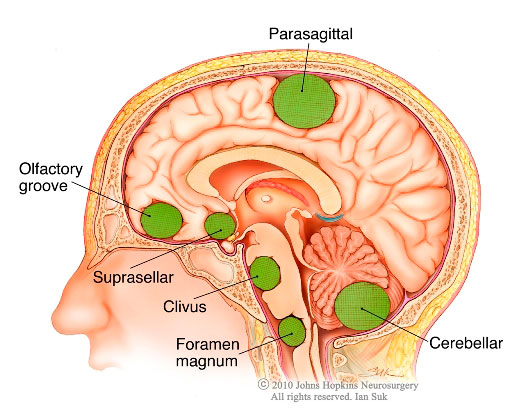Meningioma
What You Need to Know
- Meningioma is the most common type of primary brain tumor, accounting for approximately 30 percent of all brain tumors.
- These tumors originate in the meninges, which are the outer three layers of tissue between the skull and the brain that cover and protect the brain just under the skull.
- Meningiomas grow out of the middle layer of the meninges called the arachnoid. They grow slowly and may exist for years before being detected. Sometimes doctors will discover a meningioma incidentally on a magnetic resonance imaging (MRI) scan of the head or spinal cord.
Types of Meningioma

-
Convexity meningioma grows on the surface of the brain directly under the skull. Accounting for approximately 20 percent of meningiomas, convexity meningiomas may not present symptoms until the tumor has become large enough to push on the brain.
-
Falcine and parasagittal meningioma forms in or next to the falx, a very thin layer of tissue between the two sides of the brain.
-
Intraventricular meningioma forms within the ventricular system in the brain where cerebrospinal fluid (CSF) is made and distributed. An intraventricular meningioma may cause a blockage of CSF flow, leading to hydrocephalus.
-
Skull base meningioma grows in the bones that form the bottom of the skull and in the bony ridge in the back of the eyes. These are more difficult to remove surgically than convexity meningiomas.
-
Sphenoid wing meningioma forms on the skull base behind the eyes. Approximately 20 percent of meningiomas are sphenoid wing.
-
Olfactory groove meningioma forms along the nerves that run between the brain and the nose and account for around 10 percent of meningiomas. This type of tumor can cause a loss of smell, and can grow large enough to cause problems with vision.
-
Posterior fossa / petrous meningioma forms on the underside of the brain and accounts for approximately 10 percent of meningiomas. It can press on the cranial nerves, causing facial and hearing problems. Petrous meningiomas can press on the trigeminal nerve, causing a condition called trigeminal neuralgia.
-
Suprasellar meningioma arises from the base of the skull near the pituitary gland and the optic nerve. Tumors in this area can cause visual problems and dysfunction of the pituitary gland.
-
Recurrent meningioma: Any meningioma may come back. When a meningioma does recur, it may be the same grade or a more aggressive or malignant form.







